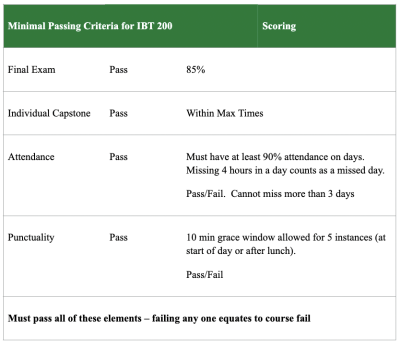Through interactive classroom instruction, hands-on lab activities, and real-world installation of photovoltaic systems, IBT 200 program participants will learn advanced solar industry skills that set them apart.
The IBT 200 curriculum was designed based on the NABCEP PV Installer Specialist Job Task Analysis. Upon graduation, trainees will receive an IBT 200 certificate of completion, as well as a certificate for OSHA-10 and CPR/First Aid training.
Safety
- Demonstrate adherence to site safety, fall protection, heat illness prevention and electrical safety plans
- Set up and explain OSHA requirements of proper ladder use
- Demonstrate proper harness inspection, fitting, and usage
- Demonstrate proper rope grab management, safety knots, and carabiner usage
Construction
- Basics Demonstrate proper hand & power tool use
- Understand how to read construction plans
- Identify studs and rafters
- Perform basic roof repairs (e.g., patching)
Electricity Basics
- Prepare and execute wire pull
- Strip wire cleanly without “rings” or nicks
- Properly crimp and splice wire
- Wire junction box and breaker box
- Wire and bond equipment grounding conductor at rails and boxes
- Understand how to read a Single Line Drawing
- Identify electrical hazards and how they can be removed or controlled
- Test components with a multimeter
- Terminate wire to appropriate torque
- Understand causes of arc flash and how and when to wear PPE
Array Installation
- Translate and mark array layout considering setbacks and shade
- Locate rafter center and mark misses
- Install flashings and mounts to manufacturer’s specifications
- Cut and splice rails to manufacturer’s specifications
- Install / align rails and bond racking according to manufacturer’s specifications
- Install MLPE to manufacturer’s specifications
- Install and align modules with safe handling
- Manage module leads/wires through proper dressing and securing of cabling
- Ensure end and mid-clamps are properly seated and torqued
- Cut and ream conduit
- Measure and bend conduit for 90-degree angle, offsets, kicks, and saddle bend
- Install EMT to electrical components, including appropriate strapping and fittings
Commissioning and O&M
- Conduct quality control checks
- Verify system production
- Prepare for inspection process
Employment Readiness
- Demonstrate effective interpersonal communication fundamentals, such as active listening and understanding
- Understand the importance of teamwork and collaboration
- Implement strategies for effective time management
- Use an iterative and collaborative approach to problem-solving
The IBT-200 course has several strict grading factors to ensure trainees are fully prepared for rewarding and demanding careers in the solar industry. Grading is a combination of a written final exam, an individual skills demonstration (capstone), attendance, and punctuality. Passing the course will require minimal scoring across all of these categories.

Confidentiality Clause:
GRID will use any personal information collected from program participants internally and share summarized data with partners and funders as part of our reporting requirements. Additionally, we may need to report job placement information for participants in federal or state job training programs.

